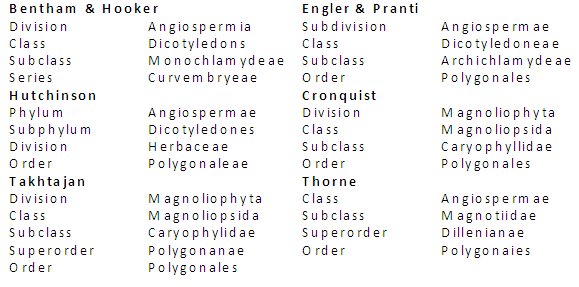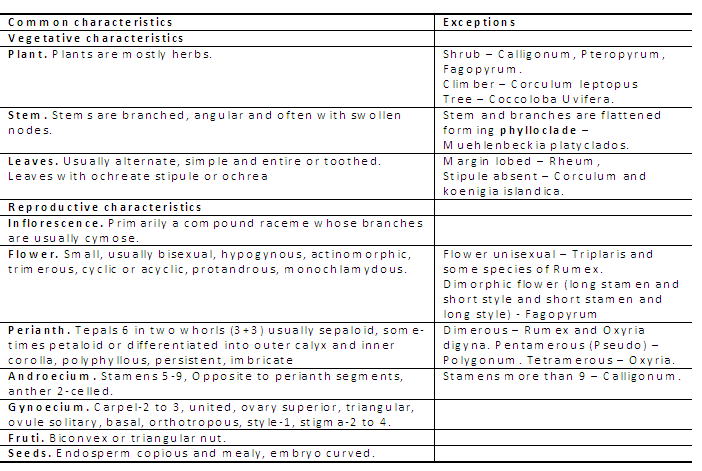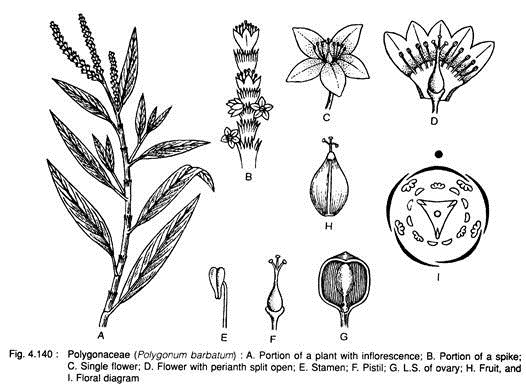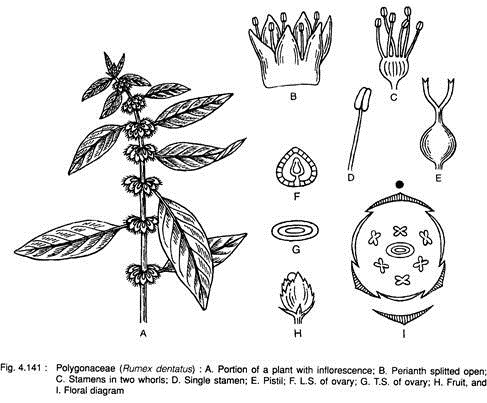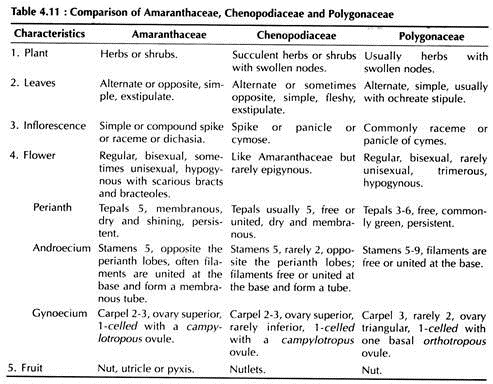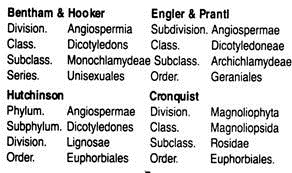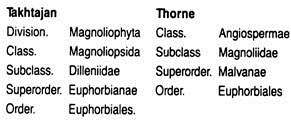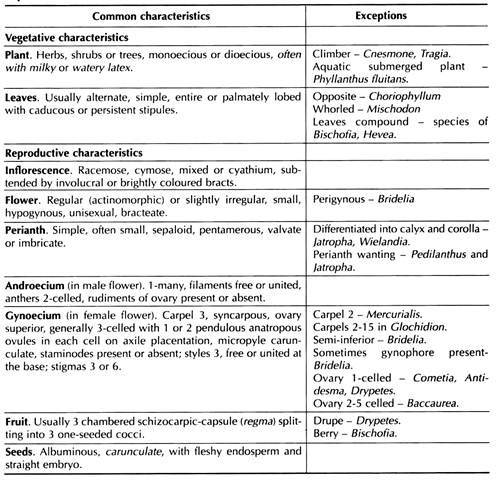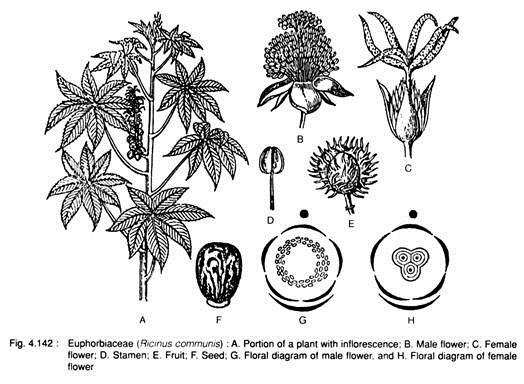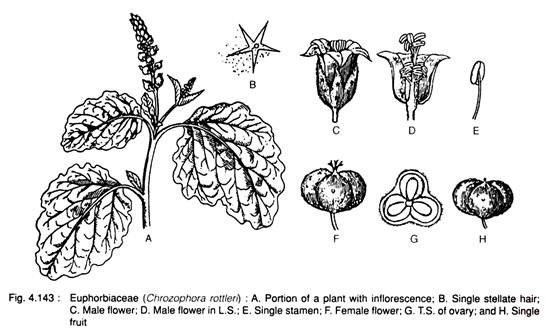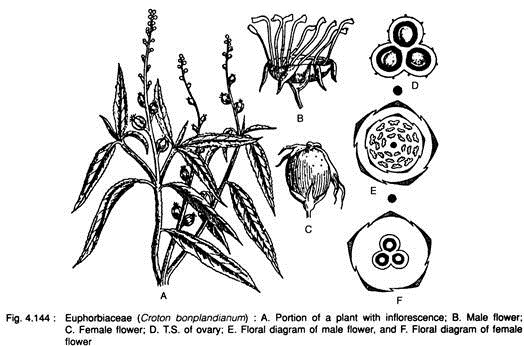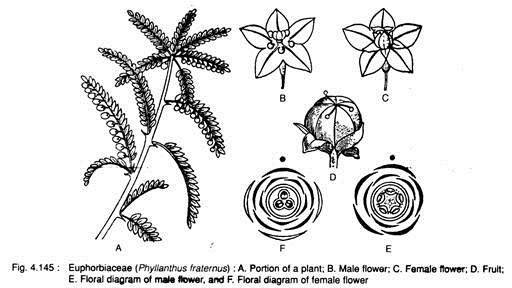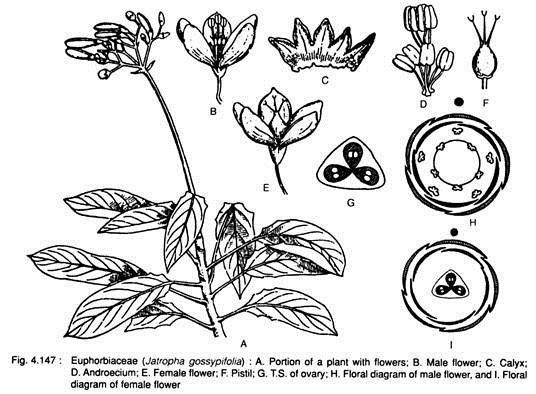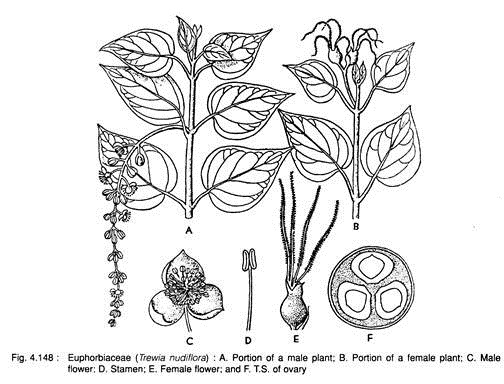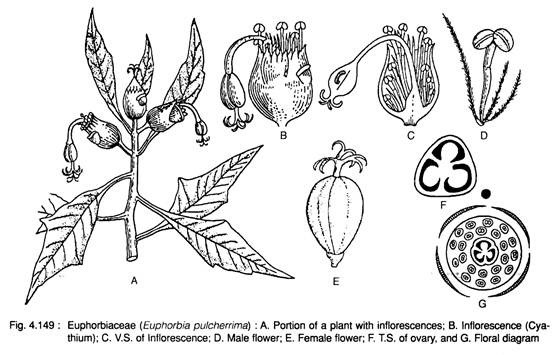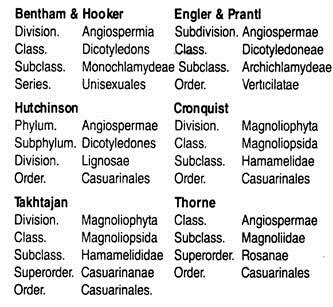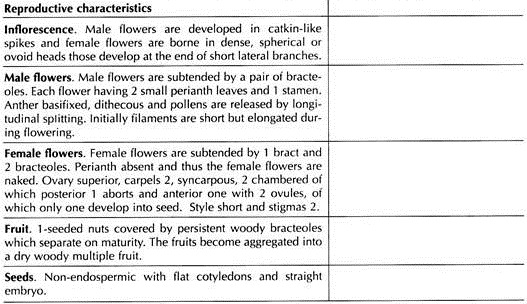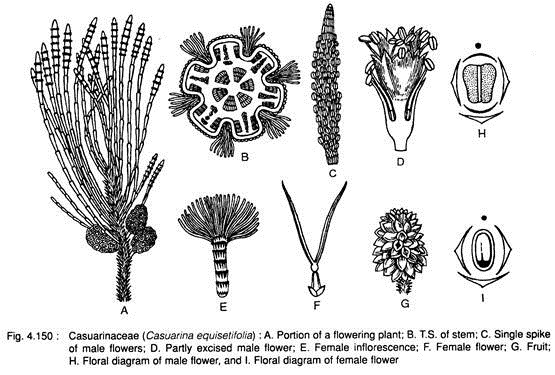ADVERTISEMENTS:
Here is a compilation of essays on the ‘Families of Dicotyledons’ for class 11 and 12. Find paragraphs, long and short essays on the ‘Families of Dicotyledons’ especially written for school and college students.
Essay # 1. Polygonaceae (Buckwheat Family):
The family Polygonaceae consists of 43 genera and 100 species, distributed mainly in the North Temperate Zone. A few species are also found in the arctic and tropical regions and also in the Southern hemisphere. Eight (8) genera and about 110 species are mainly found in Himalayas and few also in plains.
The type genus of the family is Polygonum.
Polygonaceae: Distinctive Features:
Identifying Characteristics:
ADVERTISEMENTS:
1. Generally herbs or shrubs, rarely climber or trees.
2. Stem with swollen nodes.
3. Leaves with ochreate stipule.
4. Flower usually bisexual, small and regular, monochlamydous.
5. Perianth: Tepals undifferentiated.
6. Ovary; Carpels 2-3, syncarpous, 1-chambered. Ovary superior, triangular.
7. Fruits: Trigonous nutlets.
Floral Formula:
Phytogeny and Systematics:
ADVERTISEMENTS:
The family Polygonaceae is closely related with the members of Urticaceae and Caryophyllales. It is generally regarded as a much reduced descendent of the Caryophyllales.
According to Bentham and Hooker, the natural order Polygonaceae is placed in the series Curvembryeae of sub-class Monochlamydeae under the class Dicotyledons.
Engler and Prantl placed the family Polygonaceae in the order Polygonales of sub-class Archichlamydeae under Dicotyledoneae.
Hutchinson, Takhtajan and Cronquist placed the family Polygonaceae in the order Polygonales. Hutchinson placed the order under thedivision Herbaceae of subphylum Dicotyledones. But Takhtajan and Cronquist placed the order under the subclass Rosoideae and Caryophyllidae respectively under the Class Magnoliopsida.
ADVERTISEMENTS:
Common Plants:
1. Corculum leptopus Stuntz (Syn. Antigonon leptopus HK. and Arn.);
2. Polygonum barbatum L.;
3. P. hydropiper L.;
ADVERTISEMENTS:
4. P.orientate L.;
5. Rumex maritimus L.
Key to Genera:
I. Inflorescence ending in a tendril, stipule 0 Perianth 5-cleft; climbing plant … Corculum.
II. Inflorescence not ending in a tendril, stipulate
i. Perianth 4-5; capitate stigmas…………….. Polygonum.
ADVERTISEMENTS:
ii. Perianth 6-fid, inner 3 usually enlarged in fruit; stigmas horse-shoe-shaped or peltate, fimbriated …………… Rumex.
Plants of Economic Importance:
The family has little economic importance. Some of the members are useful in respect of vegetables, food, fodder, medicine and also ornamental value.
B. Vegetables:
1. Oxyria digyna Hill, and Rumex acetosella (Garden sorrel). The leaves of the plant are used as salad.
2. Polygonum alpinum All., Rheum nobile Hook. f. & Th., R. raponticum L. and R. emodi Wall. The leaf stalks are either eaten as raw or boiled.
ADVERTISEMENTS:
3. Rumex acetosella L. (Sheep sorrel). The apical regions of the young shoots are used as salad.
C. Food:
1. Fagopyrum esculentum Moench. (Buckwheat, Kuttu) and F. tataricum Gaertn. (Duckwheat). The seeds are used as cereal because of floury endosperm.
D. Fodder:
1. Fagopyrum esculentum Moench. (Buckwheat, Kuttu) and F. tataricum Gaertn. (Duckwheat). The plants are used as green fodder.
E. Medicine:
1. Fagopyrum esculentum Moench. (Buckwheat, Kuttu) and F. tataricum Gaertn. (Duckwheat). ‘Rutin’, a flavonol glycoside, obtained from the leaves, flowers, is used in the treatment of incised capillary fragility associated with hypertension.
2. Rumex acetosella L. (Sheep sorrel). The leaves are said to be useful in the treatment of tumours, and also cancer.
3. Rheum emodi Wall., R.officinale Baill., R. palmatum L. and R. webbiana Royle. ‘Rhubarb’ a well-known drug, is prepared from the dried roots and rhizomes used as laxative, purgative and stomachic tonic.
4. Polygonum aviculare L. is used in the treatment of rheumatism, diabetes and ulcers.
F. Ornamental Plants:
Some plants are cultivated in the garden for beautification.
These are:
1. Muehlenbeckia platyclados Meissn. (Syn. Cocoloba platyclada F. Muell.). A small shrubby climber with ribbon-like green stem and branches grown in the garden as ornamental plant.
2. Corculum leptopus Stuntz. (Syn. Antigonon leptopus HK. and Arn.). A very much attractive climber with tendril and pink-coloured flowers.
Essay # 2. Euphorbiaceae (Spurge Family):
The family Euphorbiaceae is represented by 321 genera and 7,770 species, cosmopolitan in distribution except Arctic region. They grow abundantly in the tropical regions. About 61 genera and 336 species are found to grow in India commonly in the hilly regions of tropical and subtropical Himalayas and also of South India.
The type genus of the family is Euphorbia.
Systematic Position:
Euphorbiaceae: Distinctive Features:
Identifying Characteristics:
1. Plants with milky or watery latex.
2. Inflorescence cyathium, raceme, spike or cyme.
3. Flower unisexual.
4. Perianth. Tepals 5, usually in one whorl.
5. Carpel 3, ovary superior, 3-chambered with 1 or 2 ovules in each chamber on axile placentation.
6. Fruit usually regma, sometimes drupe or berry.
7. Seeds carunculate.
Variation of Stamens:
A. Variation in Number (Ranges from 1 -Numerous):
1. Stamens 1 in Euphorbia, Pedilanthus,
2. Stamens 2 or 3 in Sapium,
3. Stamens 3 in Breynia,
4. Stamens 3-5 in Phyllanthus,
5. Stamens 4-8 in Baccaurea,
6. Stamens 8 in Acalypha,
7. Stamens 10 in 2 alternate whorls in Jatropha,
8. Stamens 15 in Crozophora,
9. Stamens 8-20 in Mercurialis,
10. Stamens 15-30 in Codiaeum,
11. Stamens 80-100 in Croton.
12. Stamens several hundreds in Lasiococca, Trewia, etc.
B. Other Variations:
1. Filaments are free or united into a column in Jatropha and Breynia.
2. Polyadelphy is found in Lasiococca, Ricinus, etc.
3. Anthers are united into a ring-like common anther in Cyclanthera.
4. Sometimes androphore present in Bridelia.
Floral Formula:
Phylogeny and Systematic:
The family Euphorbiaceae is closely related to Malvales and also related to the members of Sapindales.
Bentham and Hooker placed the family in Unisexuales of subclass Monochlamydeae and class Dicotyledons. Engler and Prantl placed in Geraniales near Malvales of subclass Archichlamydeae under the class Dicotyledoneae. But Hutchinson considers the family as more or less advanced and placed it in the order Euphorbiales near Malpighiales under the division Lignosae.
Takhtajan and Cronquiest followed Hutchinson by placing it under Euphorbiales, but Takhtajan placed it close to Malvales and Cronquist near to Rhamnales.
Common Plants:
1. Acalypha indica L.;
2. A. hispida Burm. f.;
3. Bischofia javanica Bl.;
4. Chrozophora rottleri (Geis) Klotz. (Syn. C. plicata Hook, f.);
5. Croton bonplandianum Baill. (Syn. C. sperci- florum Morr.);
6. Emblica officinalis Gaertn. (Syn. Phyllanthus emblica L.);
7. Euphorbia bombaiensis Santapau (Syn. E. microphylla Heyne ex Roth);
8. E. hirta L;
9. E. nivulia Buch-Ham;
10. E. pulcherrima willd (Syn. Poinsettia pulcherrima R.Grah.);
11. Gelonium multiflorum A. Juss.;
12. Jatropha gossypi folia L.;
13. Kirganelia reticulata Bail. (Syn. Phyllanthus reticulatus Poir.);
14. Mallotus philippinensis Muell.-Arg.;
15. Pedilanthus tithymaloides (L.) Poit;
16. Phyllanthus fraternus Webster;
17. P. simplex Retz.;
18. Ricinus communis L.;
19. Sapium sehiferum Roxb.;
20. Trewia nudiflora L.
Key to Genera:
I. Flowers Aggregate, Monoecious (In Cyathium):
i. Involucre regular, each segment alternates with free gland; ovary 3-locular with 8 ovules in each … Euphorbia.
ii. Involucre slipper-shaped, drawn into a spur, glandular within…Pedilanthus.
iii. Involucre urn-shaped, single stamen……………………. Poinsettia.
II. Flowers Separate, Monoecious, not Reduced to Single Stamens and Pistils:
1. Cells of ovary 2-ovuled —
Herbs, shrubs or trees; leaves distichous, alternate; branchlets often resembling pinnate leaves; petals 0; disc of distinct scales ………………………… Phyllanthus
2. Cells of ovary 1-ovuted; flowers in spikes or racemes; sepals imbricate; petals present in male flowers—
i. Petals present or obsolete in female flowers; disc of 4-6 glands opposite the sepals ………………………Croton.
ii. Petals absent in female flowers; disc of 5-6 glands alternate with petals; garden shrubs with ornamental leaves ………………….Codiaeum.
3. Cells of ovary 1-ovuled; flowers in spikes or racemes; calyx segments 5, valvate; petals 5 in male flowers
i. Herbs or undershrubs; disc of 5 glands alternate with petals; leaves sinuate, toothed; wavy or plicate, 2-glandular at the base………….. Chrozophora.
ii. Herbs or shrubs; leaves toothed or crenate, rarely entire; flowers in racemes or spikes, male flowers without bracts, female flowers with accrescent leafy bracts; sepals 4; petals 0 … Acalypha.
iii. Tall annuals, sometimes shrubs; leaves large, broad, palmately lobed, lobes 7 or more, serrate; calyx of 3-5 valvate segments; petals of male and female flowers 0; stamens numerous, filaments united, branched; flowers in terminal panicles ……………..Ricinus.
iv. A climbing, herb with hispid stinging hairs; male sepals valvate and female sepals imbricate ………………………Tragia.
v. Trees and shrubs; leaves serrate or toothed; flowers in terminal spikes or racemes; calyx of 2-3 valvate segments; stamens 2 or 3 petals 0 in male and female flowers … Sapium.
vi. Herbs, shrubs or trees, often glandular or prickly; leaves often lobed; sepals and petals 5; stamens many, filaments of inner series united; central flowers in the cyme or in forks usually female, flowers scarlet, purple or yellow ……………Jatropha.
III. Flowers Dioecious:
1. Trees with compound leaves……….. Bischofia.
2. Plants with simple leaves –
i. Large shrubs or trees; flowers axillary or leaf-opposed clusters; petals 0; stamens 10-60; pistillode absent; disc obsolete; fruit 3-4 gonous or 2-4 lobed fleshy capsule; leaves alternate ……………….Gelonium.
ii. Trees; male flowers clustered, female subsolitary; calyx 3-6-toothed; stamens 2-5; fruit a small drupe crowned with terminal stigmas…………………………………… Drypetes.
iii. Shrubs or trees flowers in spikes or racemes; calyx 3-8-toothed; stamens 2-5; fruit a small drupe crowned with terminal stigmas ………………… Antidesma
iv. Trees; flowers in racemes; stamens 4- 8, filaments short; ovary 2-3-celled; fruit fleshy capsule; testa with a thick fleshy covering …………… Baccaurea.
v. Trees or shrubs; leaves opposite or alternate; flowers minute, apetalous in spike or panicle; stamens numerous, anther-cells 2, globose, adnate to the broad connective; fruit capsule; female flowers often with disc ……………………. Mallotus.
vi. Trees, with opposite leaves; male flowers in raceme, female flowers few, disc never present; fruit drupe; gall structures commonly occur in leaves ………………………………… Trewia.
vii. Shrubs or small trees; leaves alternate or opposite; flowers-rarely monoecious; petals in male and female flowers 0, disc 0; fruit a capsule of 3 cocci separating from the columella with twisted valves; common in salt areas of Sunderbans …………..Excoecaria.
Plants of Economic Importance:
Plants of this family have various uses.
These are:
A. Rubber:
1. Hevea brasiliensis. The latex from the stem yield good quality rubber (Para rubber), used in the manufacture of different types of rubber goods.
2. Manihot glaziovii. The rubber (Manicoba or Ceara rubber) prepared from the latex of this plant is also used in different rubber works.
B. Fruits:
1. Baccauria sapida and Cicca acida. The fruits (lotka) of the plant are edible.
C. Medicinal Plants:
1. Emblica officinalis (Emblic myrobalan, Amloki). The fruits are the rich source of vitamin C and are used for deodo- risation of mouth by chewing the fruits. It is also used in pickles and in the treatment of scurvy (bleeding from gum due to the deficiency of vitamin C).
2. Cronton bonplandianum. The latex of the plant stops bleeding immediately and it relieves pain with in a few minutes if applied at the point of wasp attack by sting.
3. C. tiglium (Purging croton). The Croton oil extracted from the seeds is used as purgative.
4. C. oblongifolia. The extract of bark is used externally for sprains (to wrench violently). E. Wood
5. Jatropha curcas. The oil extracted from the seeds is used externally to control rheumatism and skin diseases. The seed extracts are used as purgative.
6. J. gossypifolia. The leaf extract is used in the eczema and curbuncles. The roots are used to control leprosy and as a therapeutic medicine against snakebite.
7. Ricinus communis (Castor plant). The oil extracted from seeds are used as purgative. In some places the seeds are pasted and directly used as spice.
8. Synadenium grantii. The root extract is used in the preparation of ear drop.
D. Food:
1. Manihot esculenta (Syn. M. utilissima) (Cassava). The fleshy tuberous roots are rich in starch and used as valuable food stuff.
E. Wood:
1. Aporosa dioica. The woody stem is useful for different types of construction work.
2. Bischofia javanica (Bishop wood). The timber is used boats, bridges, etc.
3. Drypetes roxburghii (Syn. Putranjiva roxburghii). The wood is used during construction of house building and agricultural equipments.
4. Gelonium multiflorum. The wood is used for posts and rafters.
5. Trewia nudiflora (False white teak). The wood is used in tea boxes, match industry and other kinds of packing boxes.
F. Ornamental Plants:
The following plants are cultivated as ornamentals:
1. Acalypha hispida and A. wilkesiana.
2. Codiaeum variegatum.
3. Euphorbia milii [Syn. E. splendens (Crown-of-thorn)], E. pulcherrima [Syn. Poinsettia pulcherrima (Lalpata)], E. tirucalli (Milk-bush), etc.
4. Jatropha gossypifolia, J. multifida, J. podagrica etc.
5. Pedilanthus tithymaloides (Red bird- cactus).
Essay # 3. Casuarinaceae (She-Oak Family):
The family consists of 2 genera and 65 species and are found to grow from North East Australia to South East Asia of the Southern Hemisphere. It is a native of Australia. The genera are Casuarina and Gymnostoma.
In India, the family is represented by only one plant, the Casuarina equisetifolia (Horse-tail tree). The plant grows well in the coast of Bay of Bengal and also cultivated in different parts of the country.
The type genus of the family is Casuarina.
Systematic Position:
Casuarinaceae: Distinctive Features:
Identifying Characteristics:
1. Plants monoecious and evergreen trees or shrubby habit with xerophytic habitat;
2. Internode branches have ridges and furrows.
3. Leaves scaly and develop in whorls at each node;
4. Male flowers are borne in catkin-like spikes;
5. Each flower has 2 bracteoles, 2 perianth and 1 stamen;
6. Female flowers are developed in dense, ovoid or spherical heads;
7. Each female flower has 2 bracteoles, 2 carpels, syncarpous, 2 chambered (posterior one empty and anterior one with 2 ovules);
8. Fruit 1-seeded nut.
Floral Formula:
Systematics and Phylogeny:
The family Casuarinaceae resembles with Betulaceae in the structure and development of the pistil and ovary. The leaf and stem are highly adaptive but it is difficult to trace any affinity of this family with the Fagales. The habit of the plants under this family is related with Ephedra (a gymnosperm), suggesting the origin of angiospermous flower from Ephedra- like ancestor (Wettstein).
The family can readily be distinguished from others by its Equisetum-like jointed branches arranged in whorls, minute leaves and its woody cone-like fruits.
The family is placed under the order Unisexuales by Bentham and Hooker; Verticillatae by Engler and Prantl and Casuarinales by Hutchinson, Takhtajan, Cronquist, and Thome.
Engler and Prantl considered it the most primitive family of dicotyledons, based on the following characteristics:
1. Catkin-like male flowers with only 1 stamen,
ADVERTISEMENTS:
2. Simple wind pollinated flowers,
3. Unilocular ovary with 2 long styles,
4. Woody cone-like fruits and
5. Large rays of woods.
Rendle and Wettstein also considered Casuarinaceae to be the most primitive among the angiosperms and considered their derivation from Ephedra-like ancestor.
The other group of taxonomists like Bessey, Hutchinson, Cronquist, Takhtajan considered the family Casuarinaceae to be an advanced one derived from Hamamelidales. Based on comparative anatomy, Tippo (1938) considered the family Casuarinaceae as the highly advanced one derived from Hamamelidaceae.
Later, Moseley, in 1948, (based on anatomy) also concluded that the Casuarinaceae are a specialised family of the angiosperms and not a primitive group. The morphological studies on flower suggest that it derived from Hamamelidaceae- like ancestors. The structural simplicity of flowers of this family is due to extreme reduction.
Common Plants:
1. Casuarina equisetifolia Forst.
Plants of Economic Importance:
A. Wood:
1. Casuarina: The wood available from the several species is valuable for its hardness;
2. C. equisetifolia: The wood available from this plant is ironwood.
B. Ornamental Plants:
1. Casuarina equisetifolia: The plants are cultivated in the garden and also on seashores.

